Chronological course of an epidermal infection with filamentous biofilms
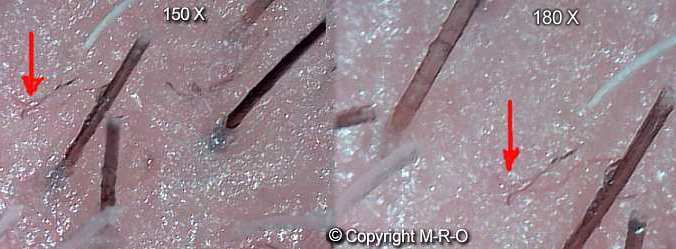
Skin contact and contamination by biofilm filaments
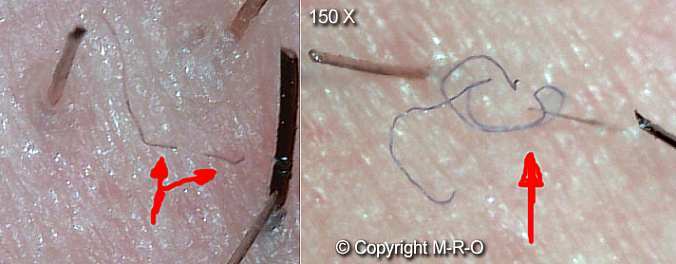
Prerequisite for germination is a nitrogen-containing and humid environment (e.g. sweat)
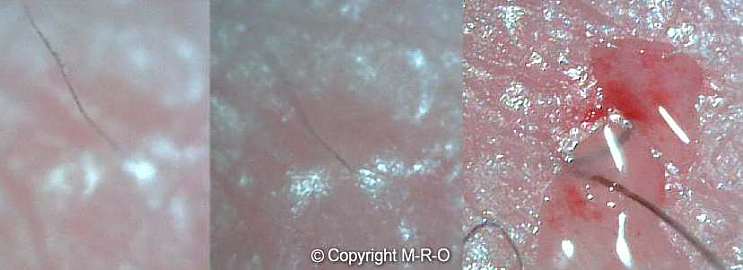
which is subcutaneously caused by the spreading biofilm and enzymatic processes.
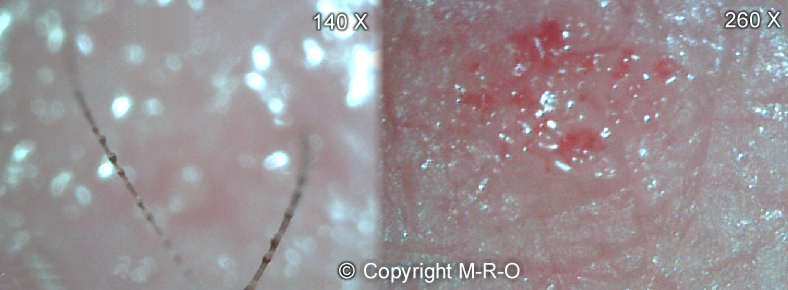
After removing the biofilm filament, the wound appears etched like after an acid treatment.
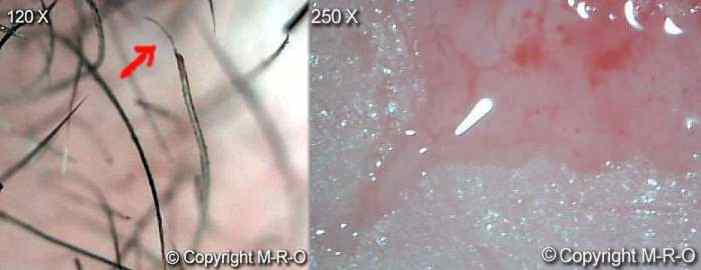
Left image shows an infested hair with filamentous biofilm. Right: Flat cutaneous spread of biofilm

The biofilm surrounds the hair like a honey-like substance and then grows further

Hair roots are also covered with biofilm

(See top and bottom pictures)

Biofilm filament snakes around a hair
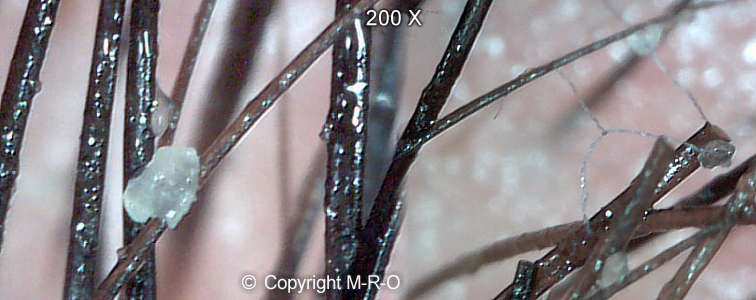
Right: Individual filaments form loops. Several result in a net-like structure,
wherein they melt together at the contact points.

Left: These are not hairs, but outgrowing filaments that are found on the host skin
Right: Sticky biofilm between hairs.
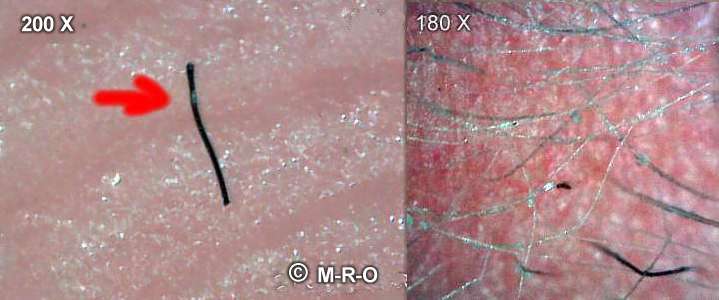
Right and bottom: Filaments grow out of nose surface
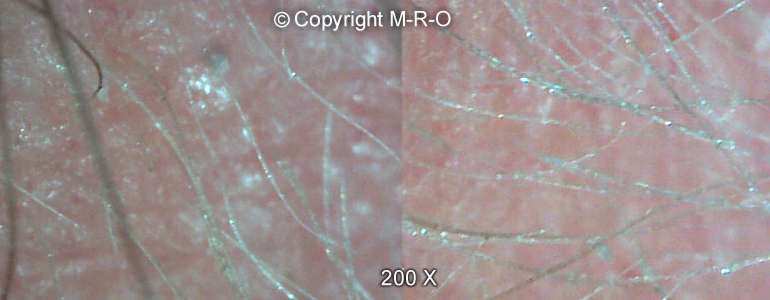
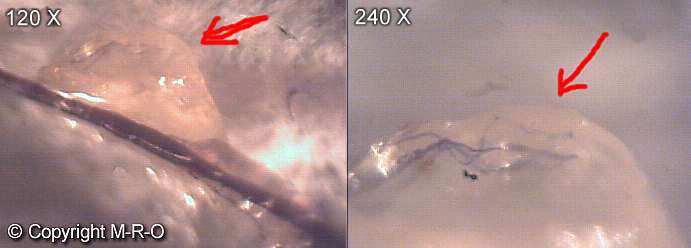
This image shows an infestation of hair with blebs or
granular biofilm shapes with integrated colored filaments
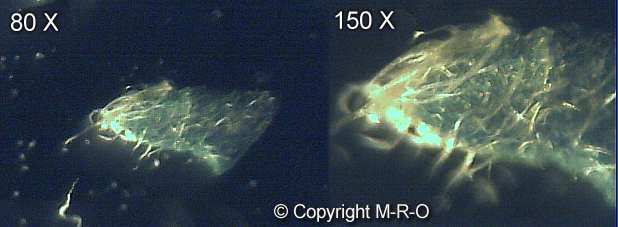
Agrobactrium Rhizobium radiobacter grow out of the main biofilm mass
Morgellons infection process:
If Morgellons biofilm-filaments or endospores are coincidentally inhaled or ingested, a person’s own health status and genetic disposition are first, and critical, lines of defense for immunity and protection against internal bacterial infection.
A host’s immunodeficiency from former or existing gastrointestinal problems, such as ulcers, GERD, Crohn disease, celiac disease, MALT disorders (mucosa associated lymphoid tissue), or other challenges, perhaps caused by stress, seems to be a crucial factor and a common denominator in the systemic disease process.
Another factor in the breakdown of immunity can be a lack of beneficial bacteria that usually cover or occupy gut cell walls, and perhaps a lack of nutrition with digestive enzymes to inhibit the settlement of foreign bacterial cells aka biofilm. The biofilm then can establish themselves in the GI tract.

Endospores embedded usually in the protective biofilm can germinate very quickly after entering the digestive tract, remaining there as long as this biofilm obtains food supply (perhaps the vegetative phase) or until they are forced out by stress or extreme diets, spicy foods or other chemicals.
The filamentous biofilm form can then develop and penetrate gut cell walls, migrate over epithelial cells and enter the blood stream, carrying also enterobacteria with it which may cause later coinfections (sepsis, lung infection).
The disease then becomes systemic, enabling it to infect the large and small bowels, liver, kidneys, glands, lung, heart, muscles, nerves, bones, gum, tongue, sinuses, eyes, brain, blood cells, lymphatic systems and lymphoid tissue, and later certainly the skin. Forcing thereby instead faster ageing of the skin, including cellulitis and an increased connective tissue damage and reduction of collagen.
Epidermal infection with filamentous biofilmsWhen speaking about a topical infection by skin contact, like pictures shown above, pH-value and composition of hormonal perspiration (nitrogen) seem to be crucial factors. The process of topical infection can take a few minutes or hours before this biofilm germinates and penetrates the host skin by its released exo-enzymes (keratinase, protease, lipase/liptase).

Penetration of skin (Stratum corneum) by a single biofilm filament causing small subcutanous swelling
Thus, because it is the same enzymatic process, most of the skin symptoms (blisters, bumbs, rash) do look like insect bites. But this topical infection remains first a local infection and not systemic. But this can happen later if particles of biofilm enters the blood stream over the lymphatic system.
There is some sort of selection process that occurs, and a clear preference for the host must be present first in order for the bacteria to settle on or not. This has been shown with most other parasites, too. Blood type, skin thickness, race or color, or weight of the host appear not to play a role.
Ask yourself: "Why are mosquitoes always biting me but not the person next to me?"
They are biting the person next to you too, but if they have a choice, they bite the first person with the proper chemistry. It is more than evident that this selection process for detecting a potential prey or host must start before this stage, before a parasite bites any prey or has first contact with its blood.
Otherwise, we would see bites that are simply exploratory, testing whether the host’s chemistry is favorable or not. In this case, what remains as orientation for some parasites are their olfactory receptors. These enable parasites to recognize hosts’ chemical evaporations and then choose the body with the right chemical composition.
IN SHORT: It is the same process as used by cells or microorganisms, called "chemotaxis," the ability of cells or organisms to direct their movement toward or away from chemicals or odor molecules (liquids or gases) selectively.
Almost all parasites must have also these abilities of "chemotaxis", by using their olfactory receptors for recognizing a potential prey or host.
And surely life forms lacking high motility, or sight and hearing capability, have developed other environmental sensors, such as a higher sensitivity to temperature, chemistry, hormones, pheromones, or light. Plants, fungi, bacteria and other microorganisms, and human cells have these capabilities.
In other words, this biofilm bacteria recognizes the right host long before it settles on it, simply via personal chemistry or odor. What, then, makes one more prone to develop Morgellons disease? Largely responsible for a topical infection is most likely, own hormonal disbalance, attractive chemistry, or composition of the sweat, and a body’s weak immune status?